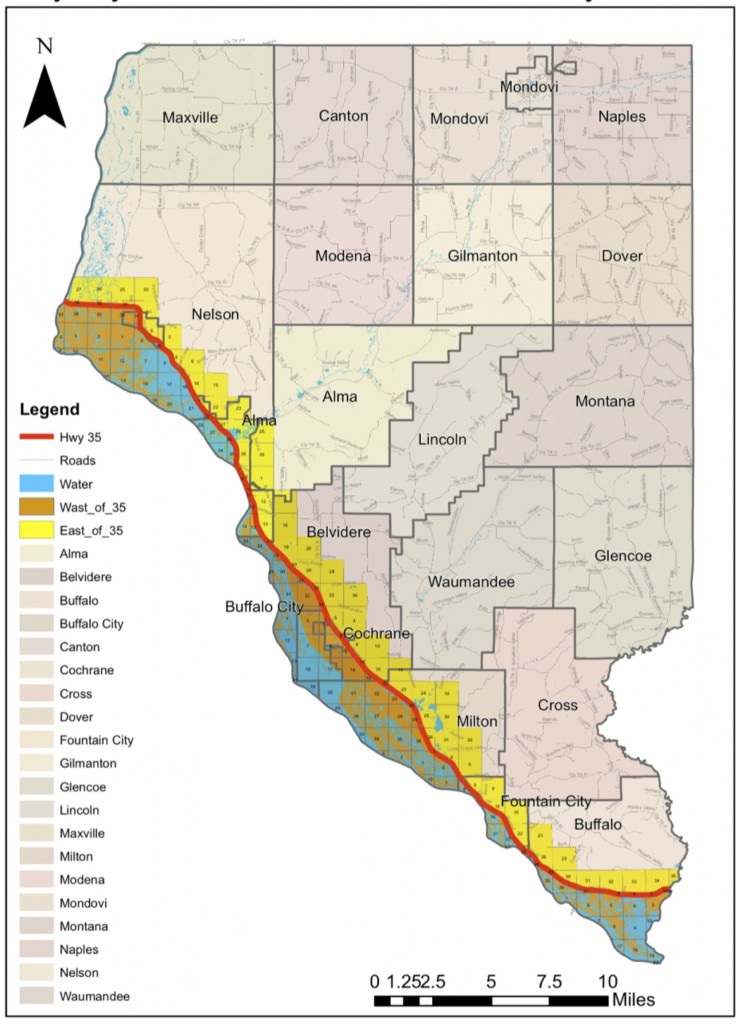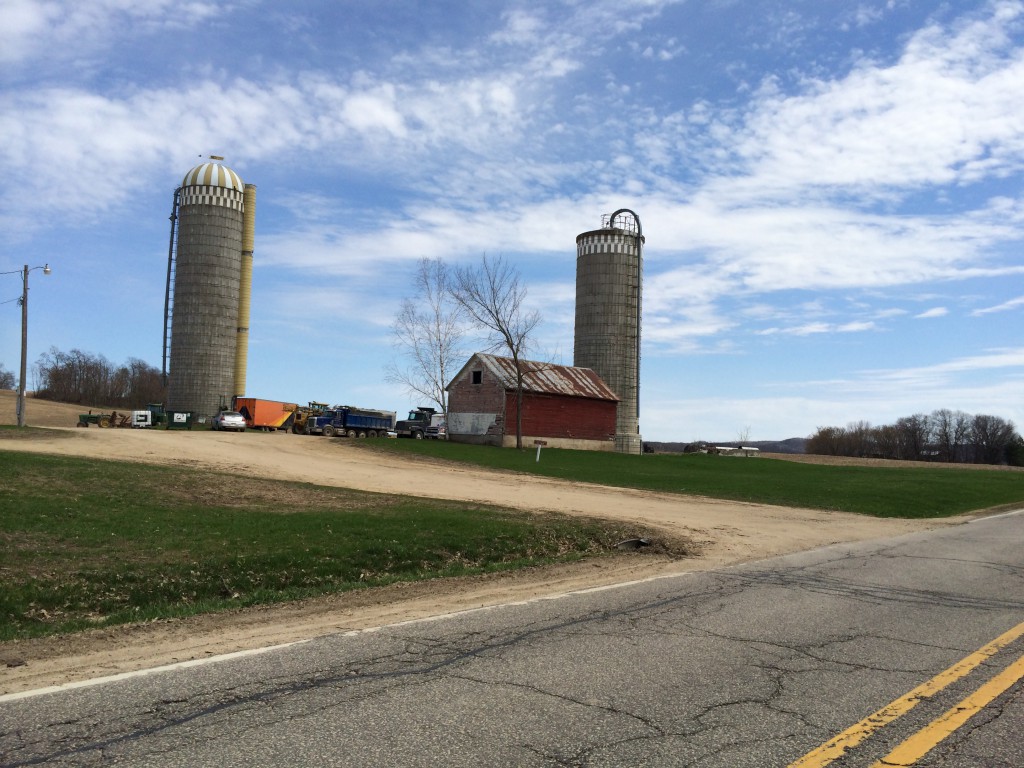Updated October 28th, 2015: The County has issued the reclamation plan for the Breezy Point mine. Click HERE to read it — pay special attention to the conditions that they have specified.
… and here’s the memo I wrote requesting that they deny the permit. All of the slope issues that I’m complaining about still exist, so we still have some work to do peepul.
PETITION TO DENY MEMO
To: Brooke Muhlack – Buffalo County, Land Conservation Director
CC: Douglas Kane – County Board, Chair
Nettie Rosenow – County Board, Land Conservation Committee Chair
Sonya Hansen – County Administrative Coordinator
From: Marcie and Mike O’Connor
Re: Breezy Point Mine Reclamation Plan – petition to deny
Date: August 14, 2015
There is a fundamental and substantive error in the analysis that underlies the reclamation plan proposed for the Breezy Point mine. The first part of this memo will demonstrate this error and explain why the plan as written must be rejected.
We follow that analysis with detailed comments describing additional deficiencies in the plan. At no time should these comments be viewed as support for the CUP Application (which is included in the reclamation plan by attachment).
Replacing 30 acres of rare Driftless Area bluff-prairie and oak-savanna habitat with low-diversity prairie plantings described as a “bluff trail” that will not be visible to anyone except the property owners is completely incompatible with surrounding land use and should not be permitted. In addition, this plan proposes at least 1.25 miles of sheer 100+ foot rock faces in the Steep Soils district that will be visible for miles.
Respectfully submitted,
Marcie and Mike O’Connor
Petition to deny the Breezy Point reclamation plan
The reclamation plan provides drawings that imply that the vertical rock faces behind the trail will total no more than 50 feet – a 35-foot lower section and a 15-foot section that is set back by 15 feet.
The following diagrams demonstrate that this is an error and show that the vertical rock faces will more than likely range from 70 to 130 feet high or more, depending on trail width and terrain. We presume this is merely a mistake on the part of the consultants preparing the plan and not a deliberate attempt to mislead county citizens and decision makers.
Here is the fundamental error. Trail designers did not account for the actual contour of the land when describing the rock face. Rather, they shifted that contour back so that in all cases the height of the rock face is the same 35 plus 15 feet. We used basic trigonometry to demonstrate that error on the following pages.
An additional error compounds the first. Trail designers used a constant 28% grade to describe the underlying terrain. This is wrong in two ways. A 28% grade is more typical on the “high side” of pastures in the centers of Driftless Area valleys as we will demonstrate with pictures of a pasture from our farm. Secondly, the contours of the land are not a constant slope. Slopes generally increase closer to the ridge-tops where mining will take place.
The final error is the presumption that sheer vertical rock-faces can be successfully planted. We will use pictures of a very small rock face on our property to demonstrate that plants don’t grow in vertical bare rock; they grow in horizontal terraces, nooks and crannies. Yet this design specifies two sheer vertical rock faces, with no slope whatsoever, behind the mined area.
Taken together, this means that the rock face will be much higher than is implied, and it will be bare. For this reason, the plan must be denied and these errors corrected before proceeding with the application process.
We request a written justification from the Land Conservation office if this reclamation is approved as drafted.
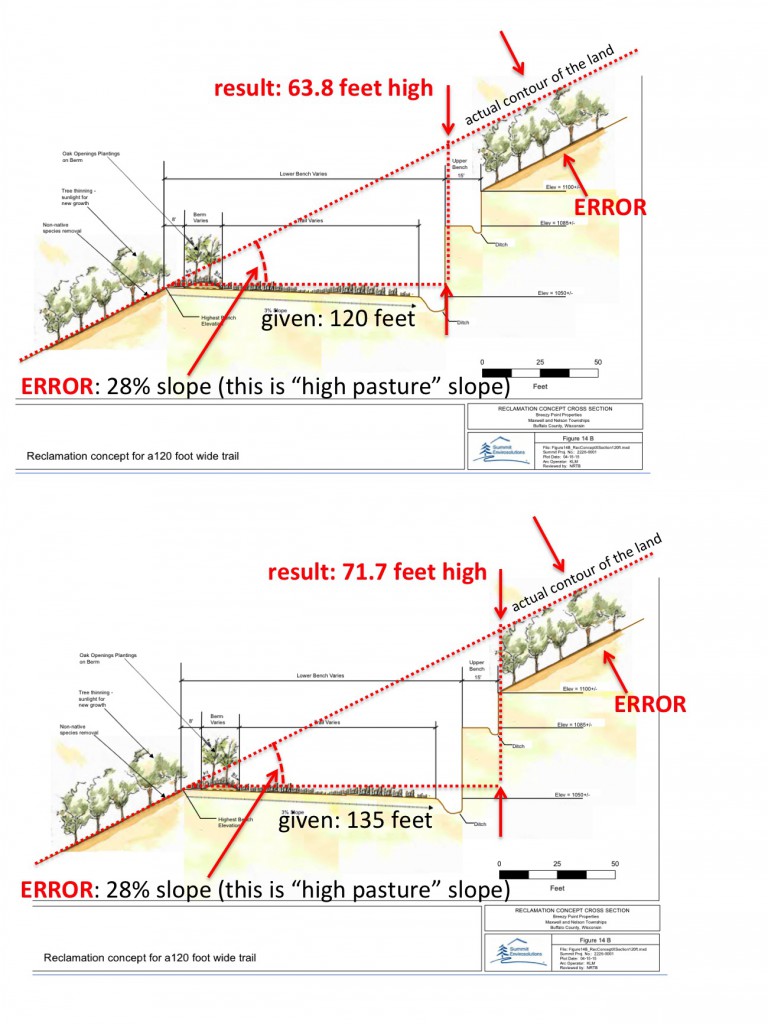 ————————–
————————–
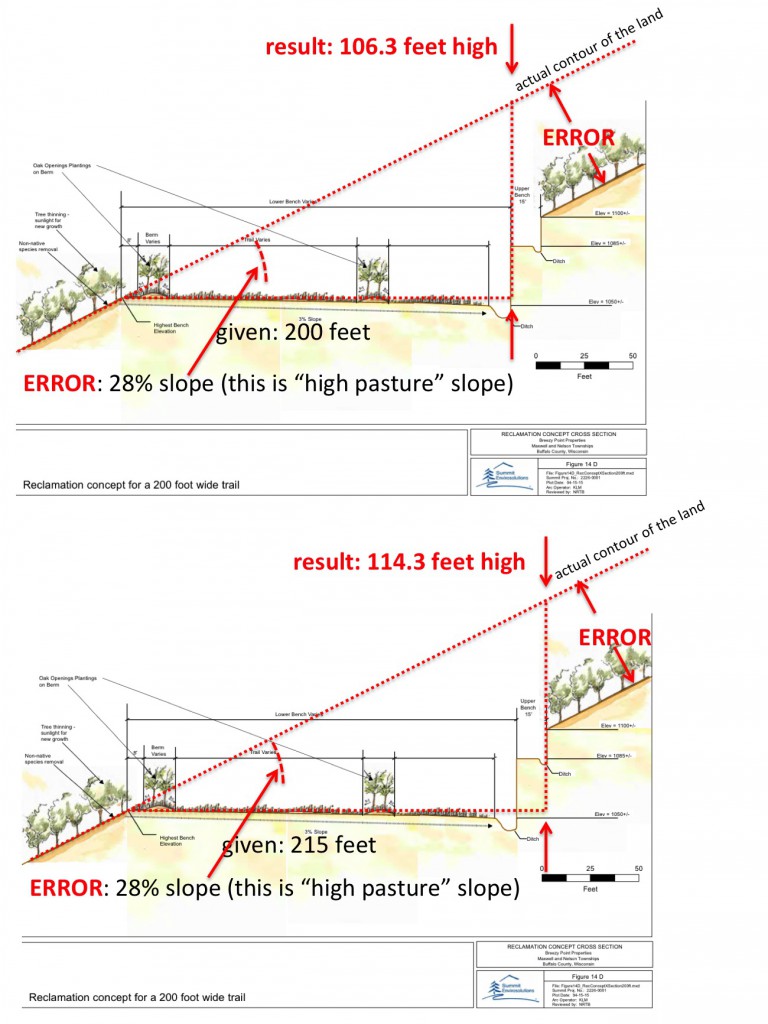 ———————————
———————————
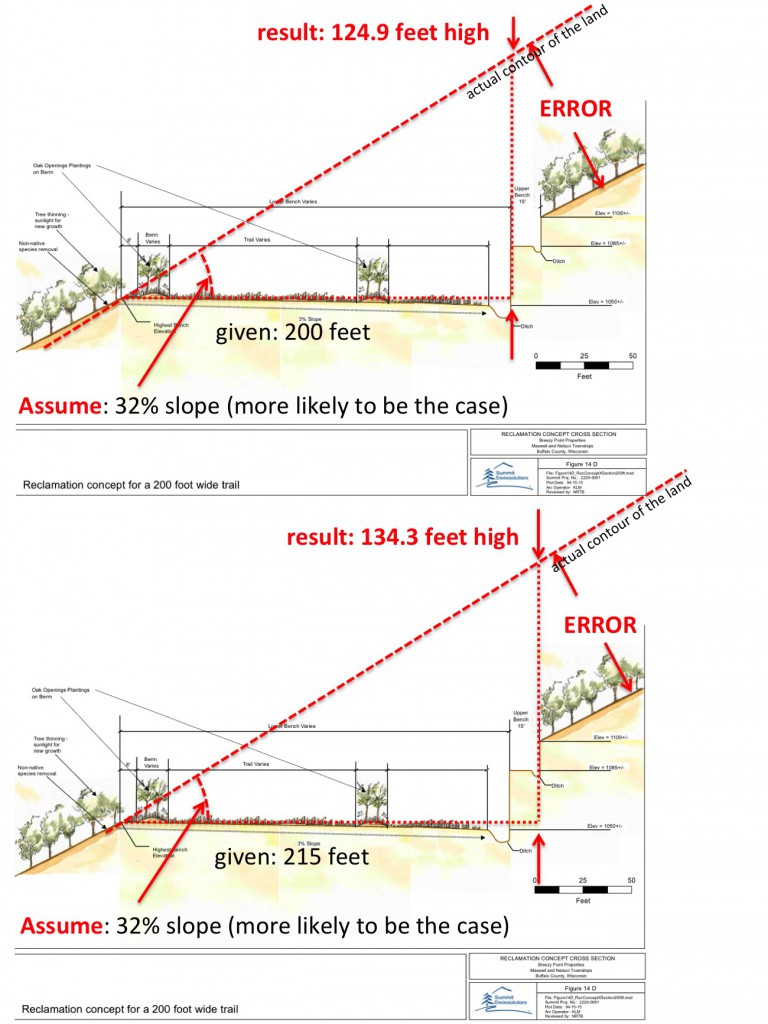 ——————————————
—————————————— ———————————
———————————
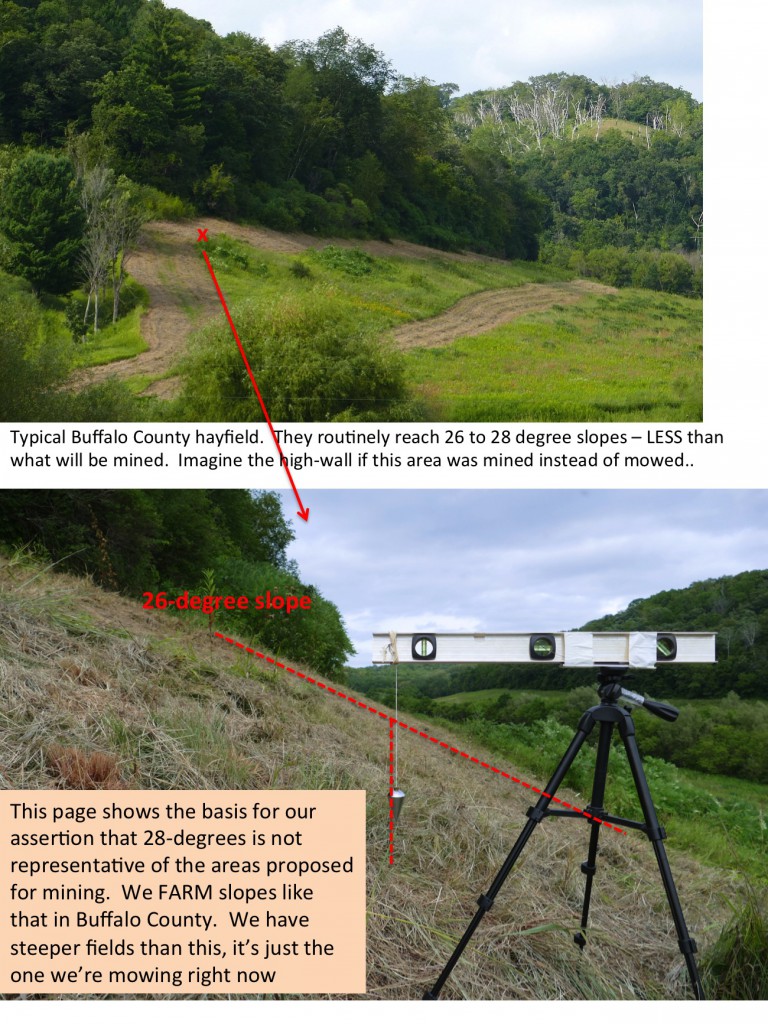 —————————————–
—————————————–
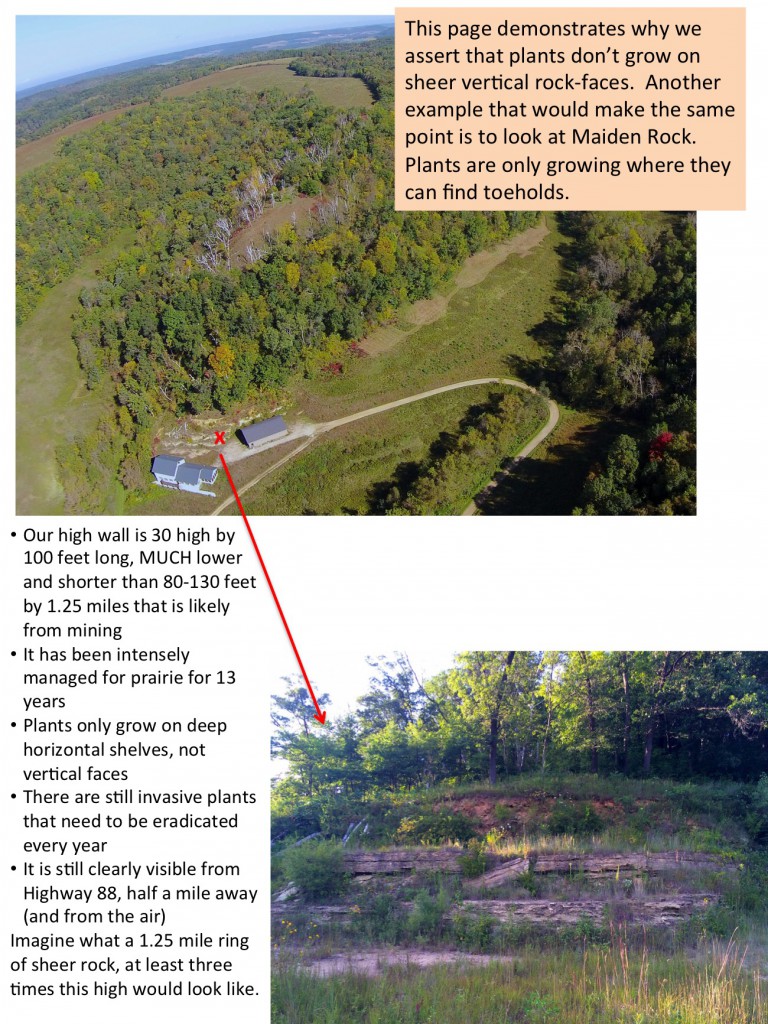 —————————————
—————————————
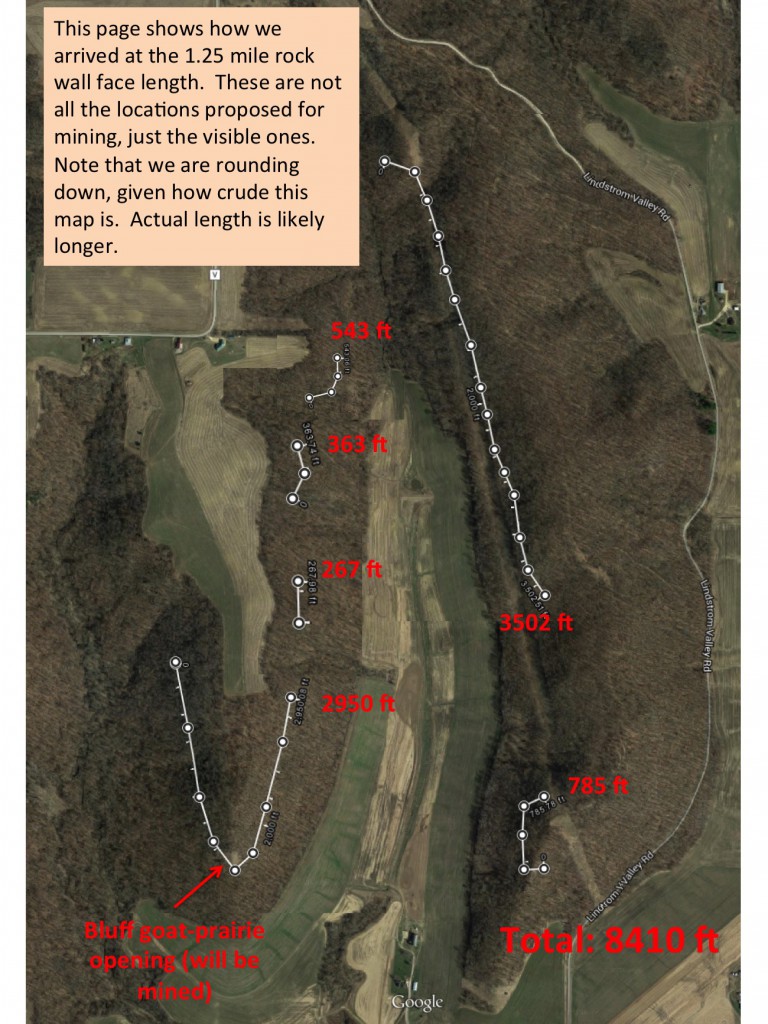
Detailed commentary on the Breezy Point reclamation plan
Financial Assurance
The reclamation plan states on Page 1, “the current and projected price of the sand beneath the mined area makes this project possible.” We suggest that those words may have been written some time ago. The need for proper financial assurances for this project is crucial and that without them, there is substantial risk that this plan will not be completed.
Most of the permitted frac sand mines in Buffalo County are either in bankruptcy or shut down, primarily due to the fact that there is no market for commodity sand that carries a substantial non value added trucking cost penalty. Buffalo County citizens and residents are already facing the prospect of unreclaimed mines.
The most recent example is the Bechel mine in Pepin County, which recently closed and left the township with a crushing financial burden.
Given the high probability that this mine will also fail financially, the financial assurances for this project need to be ironclad and funded up front. “Pay as you go” financial-assurance instruments, as provided for by DNR regulations, must not be allowed.
Project Goals
The application also states on Page 1 that the goal is to “restore the terrace to pre-settlement vegetation consisting primarily of dry prairie species, oak openings, and wet- and dry-cliff plantings.”
Change the goal of restoration from “pre-settlement vegetation” to “pre-settlement habitat.” Pre-settlement vegetation can be accomplished by simply planting a small number of species that were here in pre-settlement times. By changing the focus to “habitat”, we recognize that the goal is to reconstruct a rare ecosystem that has been destroyed.
A list of existing (pre-restoration) species that have been identified in the bluff prairies and savannas of our nearby farm is included in Appendix A. It is very likely that a survey of the Breezy Point site would find many, if not all, of these species in the degraded savanna that is being proposed for mining.
Appendix B is a much more representative sampling of the DNR “Wisconsin Natural Heritage Working List” than the one provided by the applicant. Note that we have found many of those species on our farm a few miles away. Also note that we have found those species in places very similar to the ones that are proposed for destruction by this mining project.
Once again, note that the applicant proposes to destroy rare, unique, diverse habitat that may support well over 100 species of plants and the soil that underlies them. This is why we request changing the project goal from merely planting a few plants that existed here to attempting to restore a diverse habitat that roughly approximates that which is being destroyed.
Project Methods
These comments are derived from lessons we’ve learned from the 500-acre native habitat restoration and reconstruction project we are doing on our nearby farm. Our land shares many of the same featuresof the land that is being proposed for mining – degraded savanna woodlands, bluff prairie points, wetlands, etc.
While these suggestions will not result in habitat quality comparable to that which is being destroyed, the result will at least be better than the office-park landscaping that is being proposed.
Increase the diversity and density of the plantings to improve the probability of establishing the plant species that are found in comparable environments in the county.
The reclamation plan specifies mixes according to NRCS Critical Planting Code 342 and Wisconsin Agronomy Technical note 5. These mixes are in no way representative of the habitat that is being destroyed by mining Driftless Area bluff prairies and savannas found in Buffalo County.
Appendix 3 is an example of the seed mix we used when “reconstructing” prairies by planting into old crop fields. Here is a photo of the field that was planted using this mix – 8 years after planting. Note that while there are many prairie plants, there are still invasive plants that we need to manage.
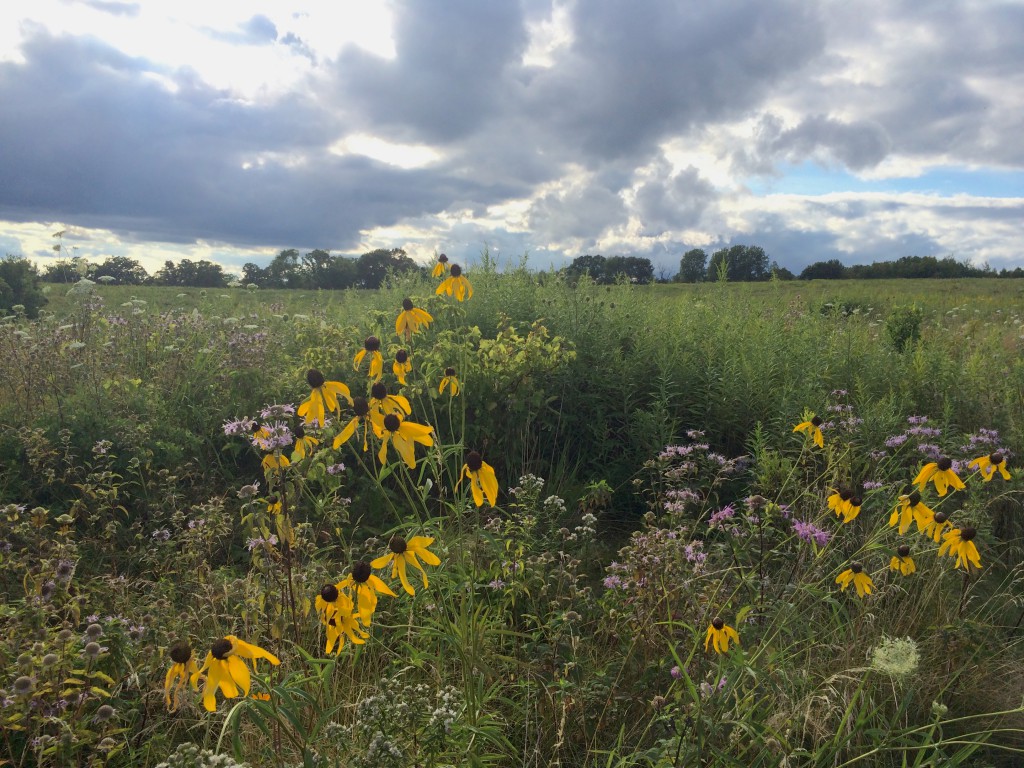
Specific recommendations on seed mix:
– Increase the density of plantings from 60 seeds per square foot to a minimum of 80 seeds per square foot. 100-120 seeds per square foot would be preferable given the budget resources available.
– Increase the seeds-per-square-foot ratio of forbs to grass
o Current plan: equal number forbs and grass per square foot
o Recommended: 75 forbs seeds per square foot, 15 grass seeds per square foot
Heavy-grass mixes like the one proposed will result in a prairie with very few forbs because the grasses are more aggressive and will crowd out the slower-developing forbs.
– Increase the pounds-per-acres ratio of grass seeds to forbs seeds in the mix
o Current Plan: 80% grass to 20% forbs by weight
o Recommended: 50% grass to 50% forbs by weight
Again, roadside and office-park erosion-control plantings that are heavy on grass are a fine thing. But Buffalo County savannas are known for the predominance of forbs and the mix that is proposed in no way resembles the diversity of the plants being destroyed.
– Increase the number of species being planted from the proposed 20-25 to 80-100 (as seen in our mix)
– Increase the number of forbs species being planted, again along the lines of the mix that we used on this prairie.
– Use local seeds (originating no more than 75 miles from the site, preferably within 25 miles of the site).
Cliff Face

The high wall must be graded and terraced, rather than vertical, in order to provide footholds for plantings.
We planted this 30-foot high post construction cliff-face about 15 years ago on our property. Note that the vertical portions of the cliff are still bare after all that time. This is why the proposal to leave a sheer vertical high wall behind the mined area is unacceptable. A 1.25-mile long vertical bare-rock scar on the landscape, visible for miles around, will never heal no matter how many seeds are planted on it.
The high wall must have slope and terraces where cliff-plantings can take hold. This photo shows that the vast majority of the plants are finding flat places to take root.
Top Soil
Do not use topsoil in areas of native plantings. The proposed reclamation plan mentions that topsoil that is removed during mining operations will not be used in areas of native plantings. We commend this approach. The degraded savanna soil now has a large seed bank of invasive species that will completely dominate the plantings if used in native-habitat restoration areas. This is exacerbated because the soil will be radically disturbed, which encourages the growth of weeds.
Using this disturbed soil as the basis for native plantings will dramatically reduce the quality of the restoration and increase the difficulty of controlling invasive plants to near impossible. Rather, use removed topsoil in other areas of the restoration and use near-sterile overburden and non-specification sand for the native-habitat restoration area.
Invasive Species Control
Dramatically extend the period of invasive-species control. A minimum of 10 years should be required, 15 is preferred, in order for native species to be able to withstand encroachment by invaders. Provide resources for periodic review and repair for an additional 5 to 15 years.
Specify A Qualified Contractor To Do the Restoration
An independent contractor, with a proven track record of native habitat restoration, should be hired to perform the restoration. Prairie Restorations (http://www.prairieresto.com/) is an example of such a company. Native habitat restoration is a skill claimed by many and mastered by few — thus the need for a proven record of accomplishment of success at such restorations.
Annual Review and Course-Correction
Specify that an annual audit of restoration activities be performed by independent organization (not the mine operator, nor the restoration contractor) and that the recommendations made during this audit are binding on the operator and the contractor.
Appendix 1 – Existing Prairie and Savanna Species Observed on the O’Connor Farm
Agalinis aspera Rough False Foxglove
Amelanchier laevis Smooth Serviceberry
Amorpha canescens Leadplant
Andropogon gerardii Big Bluestem
Anemone cylindrica Thimbleweed
Anemone quinquefolia Wood Anemone
Anemone virginiana Tall Thimbleweed
Antennaria neglecta Field Pussytoes
Antennaria plantaginifolia Plantain-leaved Pussytoes
Apocynum androsaemifolium Dogbane
Apocynum cannabinum Indian Hemp
Aquilegia canadensis Wild Columbine
Arabis lyrata Sand Cress
Artemisia campestris Wormwood
Asplenium platyneuron Ebony Spleenwort
Asclepias exaltata Poke Milkweed
Asclepias syriaca Common Milkweed
Asclepias tuberosa Butterfly Milkweed
Asclepias verticillata Whorled Milkweed
Asclepias viridiflora Green-flowered Milkweed
Aster ericoides Heath Aster
Aster laevis Smooth Aster
Aster lateriflorus Calico Aster
Aster oblongifolius Aromatic Aster
Aster oolentangiensis Sky-blue Aster
Aster sagittifolius Arrow-leaved Aster
Aster sericeus Silky Aster
Astragalus canadensis Canada Milk-vetch
Botrychium dissectum Dissected Grape-fern
Bouteloua curtipendula Side-oats Grama
Bouteloua hirsuta Hairy Grama
Bromus kalmii Prairie Brome
Bromus latiglumis Ear-leafed Brome
Calystegia spithamaea Low Bindweed
Campanula rotundifolia Harebell
Carex pensylvanica Pennsylvania Sedge
Castilleja sessiliflora Downy Yellow Painted Cup
Ceanothus americana New Jersey Tea
Cirsium altissimum Tall Thistle
Cirsium discolor Field Thistle
Commandra umbellata Bastard Toadflax
Corallorhiza odontorhiza Autumn Coralroot
Coreopsis palmata Prairie Coreopsis
Crataegus sp. Hawthorn
Cypripedium parviflorum Yellow Lady’s Slipper
Dalea purpurea Purple Prairie Clover
Desmodium canadense Showy Tick-trefoil
Elymus canadensis Wild Rye
Elymus hystrix Bottlebrush Grass
Elymus trachycaulus Slender Wheat Grass
Eragrostis spectabilis Purple Lovegrass
Erigeron pulchellus Robin’s Plantain
Eupatorium purpureum Purple Joe-pye Weed
Euphorbia corollata Flowering Spurge
Fragaria virginiana Wild Strawberry
Gallium boreale Northern Bedstraw
Gentiana alba Cream Gentian
Gentiana quinquefolia Stiff Gentian
Geranium maculatum Wild Geranium
Geum aleppicum Yellow Avens
Geum canadense White Avens
Geum triflorum Prairie Smoke
Gnaphalium obtusifolium Sweet Everlasting
Hedeoma hispida Rough Pennyroyal
Helianthemum bicknellii Hoary Frostweed
Helianthus occidentalis Western Sunflower
Heliopsis helianthoides False Sunflower
Heuchera richardsonii Prairie Alumroot
Hieracium kalmii Canada Hawkweed
Hieracium scabrum Rough Hawkweed
Hypericum pyramidatum Great St. John’s Wort
Hypoxis hirsuta Yellow Star Grass
Krigia biflora False Dandelion
Kuhnia eupatorioides False Boneset
Lathyrus venosus Veiny Pea
Lechea intermedia Pinweed
Lechea stricta Prairie Pinweed
Lespedeza capitata Round-headed Bush Clover
Liatris aspera Rough Blazing Star
Liatris cylindracea Cylindrical Blazing Star
Linum sulcatum Yellow Flax
Lithospermum canescens Hoary Puccoon
Lithospermum incisum Fringed Puccoon
Lobelia spicata Spiked Lobelia
Monarda fistulosa Monarda
Muhlenbergia cuspidata Prairie Satin Grass
Muhlenbergia racemosa Upland Wild Timothy
Oenothera biennis Evening Primrose
Oxalis violacea Violet Wood-sorrel
Packera paupercula Balsam Ragwort
Panicum oligosanthes Few-flowered Panic Grass
Pedicularis canadensis Wood Betony
Physalis heterophylla Clammy Ground Cherry
Physalis virginiana Virginia Ground Cherry
Polemonium reptans Jacob’s Ladder
Polygala sanguinea Field Milkwort
Polygala polygama Purple Milkwort
Polygala verticillata Whorled Milkwort
Potentilla arguta Prairie Cinquefoil
Prenanthes alba Lion’s Foot
Prunus americana Wild Plum
Prunus pumila Sand cherry
Pycnanthemum virginianum Mountain Mint
Ratibida pinnata Yellow Coneflower
Rosa sp. Wild Rose
Schizachyrium scoparium Little Bluestem
Scrophularia lanceolata Figwort
Sisyrinchium campestre Blue-eyed Grass
Solidago flexicaulis Zig-zag Goldenrod
Solidago missouriensis Missouri Goldenrod
Solidago nemoralis Gray Goldenrod
Solidago ptarmicoides White Goldenrod
Solidago rigida Stiff Goldenrod
Solidago speciosa Showy Goldenrod
Solidago ulmifolia Elm-leaved Goldenrod
Sorghastrum nutans Indian Grass
Spiranthes magnicamporum Great Plains Lady’s Tresses
Sporobolus heterolepis Prairie Dropseed
Stipa spartea Needle Grass
Taenidia integerrima Yellow Pimpernel
Thalictrum thalictroides Rue Anemone
Tradescantia ohiensis Common Spiderwort
Veronicastrum virginicum Culver’s Root
Viola x palmata Early Blue Violet
Viola pedata Birds Foot Violet
Viola pedatifida Prairie Violet
Viola pubescens Yellow Violet
Zigadenus elegans White Camas
Zizia aurea Golden Alexanders
Appendix 2 – Rare Plants and Animals Found in Prairies and Savannas of Western Wisconsin (Wisconsin Natural Heritage Working List and Watch List)
These are species found in prairies and savannas of western Wisconsin, that are included by the Wisconsin DNR in the Wisconsin Natural Heritage Working List – a list of species known or suspected to be rare in the state.
The DNR Natural Heritage Inventory also has a watch list – of species they’re concerned about that have experienced a decline numbers either in the state or in their entire range.
Amphibians & Reptiles
Pickerel Frog –Special Concern
Timber Rattlesnake – Special Concern
Eastern Hog-nosed Snake – Watch List
Northern Leopard Frog –Watch List
Birds
Henslow’s Sparrow – Threatened
Yellow-breasted Chat – Special Concern
Grasshopper Sparrow – Watch List
Veery – Watch List
Black-billed Cuckoo – Watch List
Yellow-billed Cuckoo – Watch List
Bobolink – Watch List
Red-headed Woodpecker – Watch List
Vesper Sparrow – Watch List
Dickcissel – Watch List
Field Sparrow – Watch List
Eastern Meadowlark – Watch List
Blue-winged Warbler – Watch List
Butterflies & Moths
Ottoe Skipper – Endangered
Phlox Moth – Endangered
Juniper Hairstreak – Special Concern
Dusted Skipper – Special Concern
Gorgone Checkerspot – Special Concern
Columbine Duskywing – Special Concern
Leadplant Flower Moth – Special Concern
Pink Streak Moth – Watch List
Wild Indigo Duskywing – Watch List
Harvester – Watch List
Leonard’s Skipper – Watch List
Eyed Brown – Watch List
Cross-line Skipper – Watch List
Little Glassy-wing – Watch List
Hickory Hairstreak – Watch List
Plants
Dragon Wormwood – Special Concern
Kitten Tails – Threatened
Hill’s Thistle – Threatened
Arrowhead Rattlebox – Special Concern
Prairie Bush-clover – Endangered
Dotted Blazing Star – Endangered
Brittle Prickly-pear – Threatened
Clustered Broomrape – Threatened
One-flowered Broomrape – Special Concern
Prairie Ragwort – Special Concern
Prairie Fame-flower – Special Concern
Small Skullcap – Endangered
White Camas – Special Concern
Autumn Coral-root – Watch List
Solidago sciaphila – Watch List
Appendix 3 – Example prairie mix (showing both species diversity and seed density) from the O’Connor farm
[Deleted from the web version of this document — too dang hard to reformat. Sorry about that.]


















